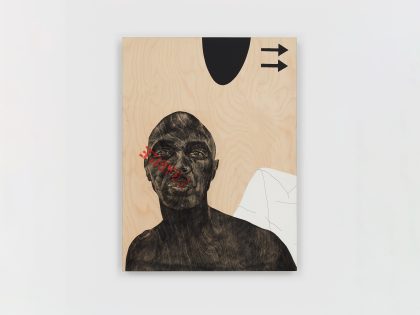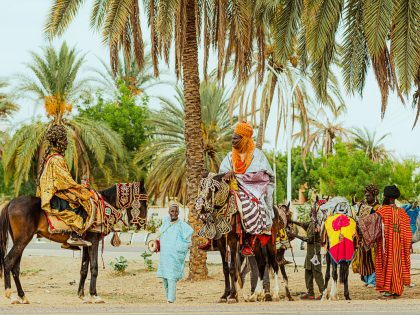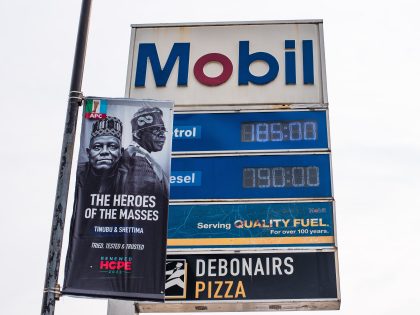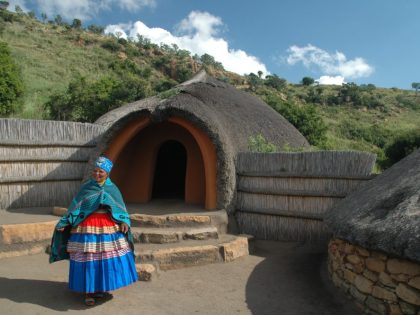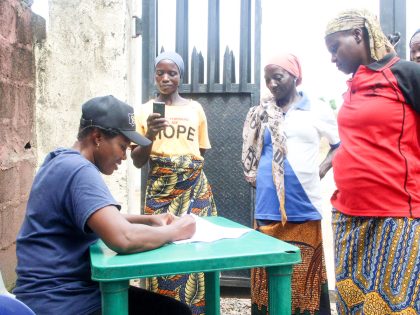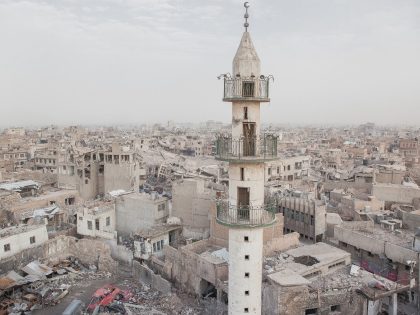The ‘Swedish Cake’ artist explains himself
Makode Linde calls his approach Afromantics: it use the blackface to show the connection between stereotypes, part of the same system of oppression.

The Swedish Minister of Culture, Lena Adelsohn-Liljeroth,cuts a piece from the crotch of a cake baked in the image of a distorted African body, complete with golliwog red lips and white eyes. Image by Marianne Lindberg De Geer.
Makode Linde seems more bemused than irritated when we discuss the huge, worldwide storm that his cake has stirred. “It’s a self-portrait. It’s not meant to represent anything, except me. People are talking about this in Africa, in South America,” he says, “there are so many different interpretations of what it means, and I don’t want to take away any of that. But it also really seems to have driven all the trolls out of the woodwork.” Strange to think that before last weekend, it was just another Afromantic.
Afromantics’ is Makode Linde’s line of artworks that use the blackface figure that has now become so infamous. The name, he says, reflects on the romanticized, supposedly positive stereotype of the happy, grinning ‘pickaninny’ (a caricature of black children) that appears on all the artworks, and is meant to show the connection between those stereotypes and the more vicious ones, all connected in the same system of oppression.
Each Afromantic is based on taking an item from Eurocentric art or popular culture and painting stereotypical blackface on top of it. “The outlines, the specific features of the faces of these items are completely obscured,” Makode Linde says, “their character is completely removed, and they have this new, supposedly ‘African’ character imposed on them.” It’s an almost painfully symbolic reproduction of the process of Othering, diverse individuals being forcibly assigned a simplistic shared identity.
When Pontus Raud of the Swedish Artists’ Organisation called in asking for the cake, Makode knew he wanted to make it an Afromantic. (Though he did briefly toy with the idea of making a chocolate Naomi Campbell.) Since the cake was to go on display in a museum, he wanted to work with something from the Eurocentric discipline of Art History, and so chose the body of the ultimate canonical classic, Venus from Willendorf, the supposed origin of a story that has always excluded African or African-bodied voices. (An accusation subtly imparted by the painted blackface.) The faceless Venus was also ideal to paint in the stereotypical looks of the Afromantic series, and to make the work more brutal and more relational he included himself as the head.
Marianne Lindberg De Geer took the picture that made the cake known, worldwide. She is also an artist, one of Sweden’s best known, and like Makode Linde’s, her work is based on identity and identification, the experience of being Othered, in her case as a woman. (In one recurring work, both like and fundamentally unlike Makode Linde, she enters into the experience of others by painting her own face over stereotypical depictions.) She knew something was about to happen, and readied her camera, pushing herself through the crowd. When the Culture minister started cutting the cake, she snapped “perhaps 25 or 30” pictures, and caught the second time the minister leans over to feed the artist, “like a mother feeding a crying child.”
“It all happened so quickly. It was horrifying, so aggressive, the scream,” Marianne Lindberg De Geer says. And for almost an hour, Makode Linde screams and screams as person after person cuts into the cake. People laugh. Some react negatively and back away. Some try to check if Makode Linde is okay, lying there in his cramped box. Some cut with happy abandon. Everyone seems to have a different reaction in the room. But no-one tried to stop it. “We were all complicit,” Marianne Lindberg De Geer says.
Me too, snapping away. We were all assured that it was alright, that it was art, that this was part of the performance. It was like the Milgram electric shock experiment, no-one stepped in to prevent the simulated pain from happening. I think it was a very good work of art. I feel I should probably apologise to Makode for ruining his work by spreading that picture.
The idea that it was a conspiracy meant to trap Sweden’s Culture Minister, as we first suggested in our first take on Linde’s performance, can probably be abandoned. None of the people I speak to–Makode Linde, Marianne Lindberg De Geer or organizer Pontus Raud–claim they knew what the other parties were going to do. Marianne Lindberg De Geer does say, though, that she probably wouldn’t have sold the picture if it hadn’t been the intensely disliked, neo-liberal Culture minister in it. “She has tried to force us all into becoming entrepreneurs,” Marianne Lindberg De Geer says, “so I decided to try to boost my income as a freelancer at her expense.”
Lying in the box was extremely uncomfortable for Makode Linde. Both physically and emotionally. “It was an experience of total objectification,” he says.
Imagine people standing half a meter from your head and talking about you as if you weren’t there. As a relational artwork, it was an artistic experience for me too.
It’s something he has experimented with before.
For a party that was also a relational performance last year, he painted twenty of his friends in blackface, and charted their reactions during the party and afterwards, when many had drunkenly forgotten their make-up and were surprised at random strangers attacking them in the street. Everyone’s experience of being inside the blackface (he describes it as if it were a shell, an item of clothing) was different, and in a way it was an artwork directed at them.
They got to experience race in a way they hadn’t before. And the aim was also to get them to experience what it’s like being Makode Linde. All of the Afromantics, whatever you think of it, are to a certain extent his self-portrait.
People always want to put me in a box. I’ve got a white mother and an African father. Whites always think of me as black. Blacks seem to always think of me as white. The media calls me Afro-Swedish, but I didn’t know what that was until last week! People seem to have trouble with the idea that you can identify with traits of both black and white, and with both male and female gender roles. There’s this categorization that frustrates me incredibly.
When I mention that he’s being accused of not being in conversation with the African diaspora, of only talking to whites, he replies:
Well, I am white. [Long pause.] And black. But I seem to have to be constructed as one of two. I don’t talk about black experience, I don’t know very much about what the ‘genuine African’ experience, in quotations, is like. I’ve grown up in the privileged inner city. What is my supposed group? Inner city mulattoes? They’re a handful. I’m not joking when I say I know them all … and they support me!
“One reason I do this,” Makode Linde adds, “is because there’s no obvious correspondence between who I am and what people think I’m supposed to be.” Thus the focus on the stereotypes, on what he talks about as “the prejudice cloud”: a collection of traits his supposed blackness, that he doesn’t feel he shares, is meant to impart upon him. That includes the blackface, the idea of “rhythm in the blood”… traits that “his race” are supposed to have in common. “And one thing no-one has mentioned about the cake,” he says, “are the neck rings. They’re not even African, they’re Burmese! And yet they just get assumed as an ‘African thing’. They’re part of the prejudice cloud too, people don’t reflect. I’ve got nothing to do with these things, nothing, and yet people expect me to relate to them.”
That, too, was the reason female genital mutilation (FGM) became part of the cake. Someone brought up the angle when they discussed the fact that the cake was to be cut up, and Makode Linde jumped on it. “It’s another part of the prejudice cloud. The idea of savages mutilating their own people.” And yet, it’s become the focus of so much of the debate surrounding the piece. “The media asks me what I think of FGM,” Makode Linde says, “what am I supposed to say? I’m against it, I tell them of course.” And suddenly it has become the aim of the artwork.
Perhaps that’s unfortunate. There is what seems to be a highly legitimate feminist critique of the piece, focused on the symbolic cutting-up of the woman and the voicelessness of female African artists, that gets wrapped up in a wider discussion about the construction of FGM that Makode Linde seems to know or care little about. The Kenyan artist Shailja Patel’s much circulated article, for instance, has many valid points, but there’s a definite sense that she and the artist are speaking at complete cross purposes. I pose the questions that Shailja Patel, in her piece at Pambazuka News, derived from theorist Jiwon Chung, to Makode Linde and his replies are probably illustrative of this:
Cui bono? Who benefits?
“The debate benefits! If female genital mutilation is the topic that should be discussed, well, it seems to have been brought up a lot. Look at Google Trends, the search volume has increased steadily since the debate started.”
How do those whose suffering / body / experience is depicted feel? Do they feel they’ve been done justice?
“The experience depicted is mine, and I do.”
Are you speaking for them (because you have a voice, and they don’t), or are they speaking for you, because what they have to say is so much more compelling than you?
“I speak for myself. Who am I supposed to speak for? I don’t represent anyone. I think the idea that an entire group that I supposedly belong to speaks with the same voice is kind of racist, too. It’s ironic that supposed anti-racists seem to be lumping people together like this.”
Are you attributing clearly (giving clear credit)?
“I’m not. I thought art was supposed to be speaking for itself. Someone on Facebook thought I should put in a disclaimer, explaining the history of blackface and why I use it, but I think if people were really interested in my art they’d think it out anyway.”
Are you dialectical?
“Look, I’ve made over 40 interviews since this thing happened. I’ve never talked about my art this much before.”
Is your ‘I’ a ‘we’? Is your ‘we’ an ‘I’?
“No. My I is an I.”
If their suffering were to disappear, would you be truly happy? Or would you have to look for something else onto which to glom your dissatisfaction?
“I think it’d be fantastic if all of these stereotypes, this prejudice cloud disappeared. If this sort of thing could be presented, and no-one would even get the reference…then I could concentrate on making music.”
Do you belong, do you truly claim solidarity with the suffering — or do you do it only when it fits in with your concerns and schedule? How do you support them outside your art?
“If there’s anything I don’t tolerate, it’s racism and homophobia. My whole life I’ve been constantly a victim of racism, homophobia and transphobia. It doesn’t seem to matter how I define myself, people always do it for me. The types of categorisation, the types of attacks, seem to be the same, no matter what kind of prejudice.”
It’s as if both Makode Linde and his feminist critics are speaking the same language of power, stereotype, intersectional oppression, and yet they don’t seem to be connecting at all. For instance, when Makode Linde raises an issue with the way anti-racism groups act, it’s one that feminists often raise too and that would be right at home in one of the articles:
I realise it’s difficult to speak without resorting to categories like ‘black’, ‘white’, ‘male’ and ‘female’. It may be difficult to demonstrate oppression without them. But at the same it’s so close-minded not to realize that placing people against their wishes in these categories is the same sort of valuation process racists use. Let people define themselves as they like. If I say I’m a white woman, let me be.
It’s no surprise Marianne Lindberg De Geer, who is one of Sweden’s most famous feminist artists, talks along a similar track.
The more I work with identity and identification, the more I realise that people are essentially the same, that you can identify across groups. I think it’s fantastic that Makode as a man takes on the role of a woman in this way, I don’t see the problem at all. Makode is an Other too.
(He really is, in multiple, intersecting ways. You should listen to him talk about having dreadlocks and meeting homophobic Rastas.)
The peculiar context of Sweden’s race relations is another thing that seems to strike a wedge between Makode Linde and his international critics. As several articles rightly point out, the reaction would have been considerably different had the cake gone on display in the United States for example. Some would argue that a nostalgic understanding of their own White goodness makes Swedes blind to racism (hence the audience response), but Makode Linde has another take, too:
We don’t have the same history here in Sweden of slavery, of colonialist oppression. Our colonies were barely there. We don’t have the ‘guilt quilt’ big colonialist nations have, and yet we’re constantly asked to relate to the same issues of slavery and segregation that, say, the United States does. It’s as if our race relations are imported from the US, and the whole issue becomes almost a meta- or quasi-discussion.
Perhaps this is the reason blackface passes with less resistance in Sweden. But it’s probably also the reason that institutions that think of themselves as non-racist don’t deal with their own prejudice, because the general image is that Sweden doesn’t have much racism. And yet, looking at the actual situation, there’s staggering discrimination in healthcare, schools, in the justice system, in the labour market. And in higher education, as brought home with characteristic irony by Makode Linde in another of his artworks, where he comments on exposure, class and the over-representation of white students at the University College of Arts, Crafts and Design by baking oat balls in different colours.
He staged it at the school, and people laughed, until laughter “got stuck in their throats” once the realisation set in. “I think it’s a very Swedish approach,” says Makode Linde. “And a very effective one. Here it’s always been considered strange to take yourself completely seriously. Gays and Jewish people, too, have been using humour about racism and homophobia as a defense mechanism for a long time. In stand-up comedy, the sort of thing I do would pass unnoticed. Yet in the art world, joking about certain things is considered taboo, even if the intent is not racist. If there’s any problem I have with justice movements, it’s their lack of this sense of humour.” That, too, is perhaps an aspect of the cake that translates less well.
And yet Makode Linde has relished the debate and the different angles it has brought up. “People have so many interesting points of view on this,” he says. “The debate really seems to have benefitted, and even stuff like other videos of mine and other artists working on similar themes have been given a boost. That’s why I don’t buy the argument that I’m silencing other artists, it’s not like there’s one-–sorry for this one!-–attention cake that I’ve taken too large a chunk out of.” And he intends to keep working with the same themes, and the new things raised by the cake: “I’m following it all closely. And as a free artist I reserve the right to reinterpret my work and spin off new things in the future.”










